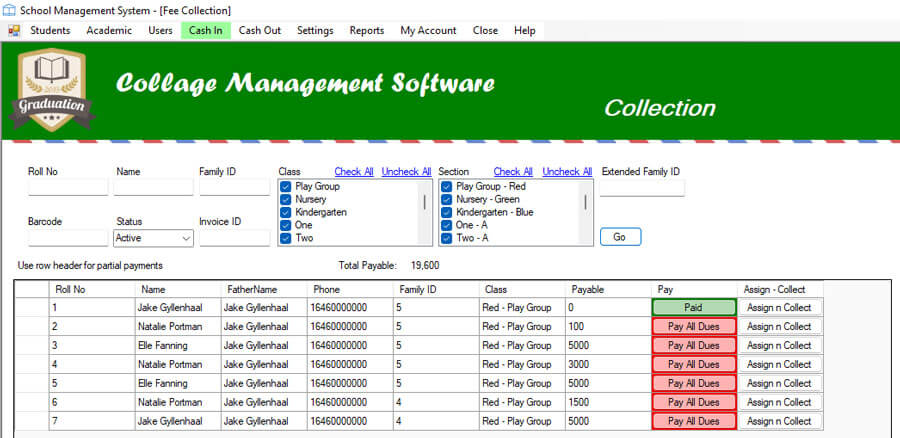School billing software
SoftwareLinkers offers the best school billing software to streamline your fee management. Our solution is an affordable fee management system for schools, colleges, and preschools, enabling automated billing, recurring billing for schools, and tuition fee management. With multiple payment gateway integration and secure data storage, it features desktop-based school billing, custom invoice templates, late fee calculation, and real-time reports and analytics—perfect for education institutions.
Core Features of Education Billing System
Let’s break down what makes an education billing system. It’s not just a glorified spreadsheet. It packs serious features that help schools stay on top of their finances effortlessly.
Student Fee Tracking
Easily track payments made by each student, including installments, scholarships, and concessions. Everything is stored and updated in real-time.
Recurring Billing for Schools
Set up automated billing cycles—monthly, quarterly, annually—so you never miss charging a fee.
Late Fee Calculation
No more manual calculations. Automatically add late charges based on pre-defined rules.
Real-Time Reports and Analytics
Instantly access data-driven insights. Know how much has been collected, what’s pending, and get detailed breakdowns.
Custom Fee Vouchers / Invoices
Send professionally branded receipts that match your school’s identity and edit them as you wish.
Secure Data Storage
All financial and student data is encrypted and backed up, ensuring high-level security compliance. The data is stored on your local computer, so it is free from hacking risks.
When you think about it, these features don’t just handle billing—they help schools evolve into smarter, more efficient organizations. It’s about moving from chaos to clarity, one invoice at a time.
How School Accounting Software Simplifies Finance Management
Gone are the days when schools relied on traditional accounting books or standalone Excel sheets. With school management software, the finance department can breathe easily. It automates tedious tasks like journal entries, reconciliations, and ledger updates, ensuring everything is error-free and audit-ready.
Top Benefits of Using Student Fee Collection Software
Minimized Human Error: Say goodbye to missed entries or duplicate invoices. Automation ensures everything is precise.
Transparency for Parents and Staff: Both sides can view the transaction history, receipts, and outstanding balances in real-time. No more disputes.
Time Savings: Imagine generating 1000+ fee invoices/vouchers in seconds. Now multiply that efficiency by every billing cycle.
Cost Reduction: Less paperwork, fewer manual hours, and fewer errors mean reduced administrative overhead.
Enhanced Reporting: Whether it’s a board meeting or a financial audit, you’ll have the numbers ready—accurate and updated.

Detailed Features
- Fee invoice
- Fee assignment
- Occasional fee assignment
- Assign a single student fee
- Fee voucher/chalan
- Family-based Fee voucher/chalan
- Fee collection
- Family-based fee collection
- Fee structure
- Standard fee setting
- Bulk fee update
- Different payment methods
- Commitments
- Edit fee (payments)
- Fee detail
- Fee history with user (accountant)
- Multiple fee reports
- Daily, weekly, monthly, and yearly fee report
- Fee receipt
- Fee transaction
- Billing summary by date
- Billing summary by challan
- Fee balance report
- Payable fee report
Integration with Student Management Systems
Efficiency is at its peak when billing software integrates with student management system. These modules—when working together—create a seamless environment where data flows automatically between academics, admissions, attendance, and finance.
Imagine enrolling a student, assigning their class and electives, and having their entire tuition fee management profile built automatically. That’s the power of integration.
It also minimizes errors, reduces administrative load, and ensures that all systems “speak the same language.” No more spreadsheets or manual cross-checking.
